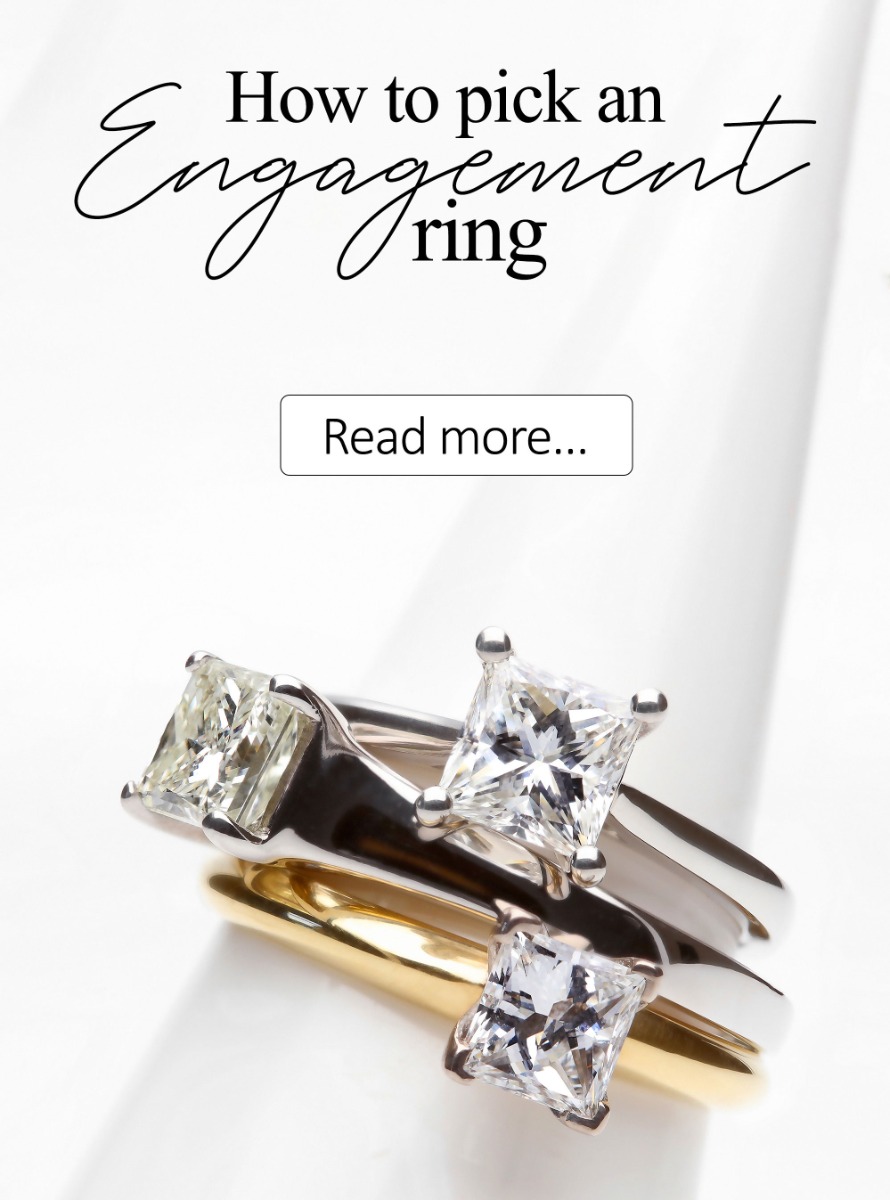The William May Birthstone Guide
Birthstones have a long history, and have been found to date as far back as the first century. Over the years, they have evolved and changed to the modern list that we know today. William May has gathered everything you need to know about the birthstones for each month, including colours, legends and the supposed properties each one brings to the wearer.
What is a birthstone?
A birthstone is a gemstone that represents a month of the year. Traditionally, each month will have one gemstone assigned to it, although some months have been assigned multiple birthstones as the list has developed, often to ensure that there is an affordable variety of stones for everyone. People often wear birthstones to represent the month they were born in – for example, someone born in January may wear a piece of jewellery with a garnet setting. For hundreds of years, gemstones have been thought to embody healing properties. Legend says that birthstones hold the strongest power for anyone born in their corresponding month, but for the full effect, a person must own one of each and alternate them monthly.
January birthstone
Gemstone: Garnet
The birthstone of January is the garnet. Although the colour that springs to mind is a deep and rich red, garnets are actually found in a variety of shades such as oranges, browns, greens and even pinks and purples.
Ancient folklore has a lot to say about garnets. The stone is thought to bring the wearer peace, wealth and good health. Do good while wearing a garnet, and more good will come your way. But do bad, and misfortune will follow you.
Because of the deep colour of the garnet, it is also thought to symbolise a long-lasting friendship and a deep connection. Are you a January baby?
Take a look at our garnet collection today.
February birthstone
Gemstone: Amethyst
Amethyst, the February birthstone, is one of the most popular and well-known gemstones around. Recognisable by its gorgeous purple hue, the amethyst’s colour can actually range from a deep violet to a very pale lilac, and can even venture into the red end of the colour spectrum.
February is often one of the coldest, wettest and darkest months of the year (not to mention the shortest), so amethyst is thought to counteract any bad feelings that may arise with stability, bravery and peace. For those who may need a little more strength at this time of year, legend says that amethyst will bring you warmth and comfort.
The name amethyst comes from the Ancient Greek word of ‘amethystos’, which means ‘intoxicated’. People in this time believed that wearing an amethyst would prevent them from getting too drunk.
Were you born in February? Harness the balancing powers of the amethyst and browse our gorgeous collection.
March birthstone
Gemstone: Aquamarine
The March birthstone, aquamarine, is synonymous with the ocean, which isn’t surprising given its name and the incredibly serene colour. The name comes from the Latin words of ‘aqua’, meaning water, and ‘marina’, which means the sea. Aquamarine gemstones can vary in colour from the common lighter and paler blue, to a darker green blue.
The larger the stone, the more intense the colour tends to be. Aquamarine gemstones that are a darker blue are rare and very valuable.
For hundreds of years, aquamarine has long been associated with eternal life due to its connections with the ocean. Because of its soothing colour, it is also a symbol of hope, health, fidelity and youth.
If you were born in March, why not carry the stunning colour of aquamarine with you everywhere you go? Take a look at our collection.
April birthstone
Gemstone: Diamond
The diamond is April’s birthstone, and is possibly the most widely known gem of them all. Our fascination with them is nothing new, as diamonds have been admired since ancient times. Considered a symbol of eternal love, they are the most common stones used in engagement rings.
The folklore surrounding diamonds goes back a long way. For hundreds of years people believed that diamonds were formed when bolts of lightning hit rocks and changed them into the beautiful stones we know today. Diamonds take millions of years to form from carbon and are thought to be the hardest stone on Earth.
Diamonds can come in several colours, although the colourless stone is the most famous. They come in yellow, red, pink, green and blue hues and the strength of the colour varies dramatically. The more saturated the colour, the higher the value of the diamond.
There is a very careful valuation process for diamonds, something that was only introduced in the 20th century. The standard of valuation around the world will look at the ‘4Cs of Diamond Quality’: colour, clarity, cut and carat weight.
Feel like finding your new best friend? Take a look at our gorgeous diamond collection here.
May birthstone
Gemstone: Emerald
Emerald is May’s birthstone, and the colour embodies the true essence of spring. The stone itself symbolises rebirth and love.
Emeralds have long been associated with Venus, the Roman goddess of love and romance, and were believed to help fertility when worn.
They have a history stretching as far back as the Ancient Egyptians. Cleopatra famously wore emeralds and the dead were often buried with them as a symbol of eternal youth in the afterlife.
The more vivid and deeper the colour, the more valuable the emerald. But the most prized emeralds are not necessarily pure green, as the most beautiful often have a strong blue tint.
Going green with envy over emeralds? Add one to your own collection today.
June birthstone
Gemstone: Pearl
June is the first month of the year to have two birthstones assigned to it, the first of which is pearl.
They are the most unique gemstone of them all, because they are formed by a living creature rather than from natural rock formations. Freshwater pearls are very rare and difficult to retrieve, so methods to create man-made pearls have developed over the years.
Pearls have a rich history. In Persian mythology, pearls were called ‘the tears of the gods’, while legends from Ancient China claimed that pearls were created by the power of the moon, infusing them with a celestial glow and air of mystery.
Cultured pearls can come in a whole rainbow of different colours, from white and pale cream to a subtle rose or lilac, through to green, gold, grey and even black.
Pearls make a stunning addition to any outfit, so why not add them to your wardrobe?
Gemstone: Alexandrite
June’s second birthstone, alexandrite, is a rather modern gem that is thought to have been discovered in 1834 in Russian emerald mines. Legend has it that it was found on the same day that the Czar Alexander II came of age, and was named in his honour.
It is possibly one of the most unique rocks out there, as it actually changes colour depending on the light. This stone, described as ‘emerald by day, ruby by night’, contains a rare mineral called chrysoberyl that changes colour from a blue-green in fluorescent light to a purple-red under incandescent light.
Given its incredible chameleon-like properties, it’s no surprise that alexandrite has been revered for its mystery and lore. Wearing alexandrite is thought to strengthen a person’s intuition, spark the imagination and give a boost to creativity.
July birthstone
Gemstone: Ruby
July’s birthstone is the ruby. Long considered to be the king of all gemstones, it was once the prized possession of kings, emperors and royalty around the world. Even in the modern world the ruby is still a valuable stone.
The colour of the ruby is the most important consideration to take into account, particularly when it comes to valuation. The shade of a ruby can vary from a purple red hue to a lighter orange-red.
It measures 9 on the Mohs scale making it the second hardest gemstone, second only to diamond. The most valuable colour is called a ‘Burmese Ruby’, which has a very rich, full and hot red colour, with a slight blue tint.
So far, this colour of ruby has only been found in the Mogok Valley mines of Myanmar. Same as the colour red, rubies symbolise passion and energy, and are thought to bring success and love to the wearer.
Add the breathtaking power of the ruby to your jewellery collection today.
August birthstone
Gemstone: Peridot
Peridot is one of the two birthstones of August, and it is unusual because it is one of the only gemstones that comes in a single colour. While other gemstones can vary across the entire colour spectrum at times, peridot only comes in a lime green, making it a bold choice for jewellery.
The lore behind the peridot stone dates back to ancient times, when it was believed to be a gift to Earth from Mother Nature to commemorate the creation of the new world each year.
When it is given as a gift, it is thought to give the receiver magical powers and provide protection from nightmares.
Take a peek at our peridot gemstone jewellery collection.
Gemstone: Spinel
The second birthstone of August is spinel, once referred to in Sanskrit writings as ‘the daughter of ruby’. As the name suggests, spinel and rubies are very close in colour, meaning that spinel is often mistaken for its close relative. However, spinel gemstones are rarer than rubies and can often be found in large stones (unlike rubies, which tend to stay small). The rarest of all spinel stones comes in a blue, but chances are you won’t come across one of these.
Speaking of blue, if you’re feeling a little low, spinel is believed to soothe away any feelings of sadness, healing friendships and relationships, and protecting the wearer from harm.
Explore our stunning spinel collection today. You’ll soon fall in love with this beautiful gem.
September birthstone
Gemstone: Sapphire
September’s birthstone is the sapphire, which immediately brings to mind a deep ocean blue. Although this colour is incredibly well known, this stone can actually come in a whole spectrum of different colours such as yellow, orange, purple and pink – these are called ‘fancies’. One colour sapphires don’t come in, however, is red.
The rarest sapphire of them all is called the Padparadscha, which is a beautiful shade of pink-orange, a pale salmon colour that looks like a tropical sunset. These are highly coveted, but also difficult to find.
For hundreds of years, the sapphire has been synonymous with trust, honest, purity and loyalty, so it’s not surprising that it’s a popular gemstone for engagement rings.
Add this gem of kings to your jewellery box. We have dozens of sapphires in our collection, so take a look today.
October birthstone
Gemstone: Opal
The first birthstone of October is the opal; the national gemstone of Australia. Hundreds of years ago, people would refer to the opal as the ‘Queen of Gems’ because of its multi-coloured appearance, encompassing a whole rainbow. It appears to change colour as it catches the light, with the most valuable and prized opals featuring all colours within an intricate pattern.
Opals have long been associated with bringing good luck to the wearer. However, legend states that that wearing opals can bring bad luck to anyone who wasn’t born in October.
No one is really sure where these rumours originated as there are dozens of stories. Some believe that when jewellers were unsure of proper handling and cutting techniques, opals would dry out and break and this was considered unlucky.
Ready to feel lucky? Add opals to your collection.
Gemstone: Tourmaline
October’s second birthstone is tourmaline. The name means ‘mixed stone’, which is incredibly fitting, as tourmaline can be found in a whole rainbow of different colours. From mint and olive green to ocean blue, deep violet, pink, peach, yellow, orange, magenta and red, there’s something to suit every taste and every outfit.
Hundreds of years ago, magicians used darker and black tourmaline stones to provide protection from negative thoughts, energy and evil. Even today some people believe that tourmaline can provide protection from radiation, toxins, negativity and pollution.
Pink tourmaline stones are associated with love, compassion and happiness, while green gems promotes healing.
November birthstone
Gemstone: Topaz
Topaz is one of November’s two birthstones, coming in a wide variety of colours. Although the purest form of topaz is colourless and transparent, the majority of the time it’s tinted by impurities to give the stone its colour.
The most common topaz shades are yellow, amber gold or a pale orange pink. The rarest is known as ‘Imperial Topaz’, which is a strong orange hue with pink undertones. Naturally, blue topaz stones are incredibly rare.
In Roman and Ancient Egyptian times, topaz had strong links with the sun gods, and the stones were believed to have healing and protecting powers. It’s also thought to have a balancing and calming effect on human emotions, as well as being able to release tension and bring joy to the wearer.
Mesmerised by the colours of topaz? Explore our collection today.
Gemstone: Citrine
Citrine is November’s second birthstone. The name originates from the term ‘citron fruit’ to describe the pale yellow colouring of lemons, but the colours of this birthstone can range from a brighter yellow hue to a more subtle orange-brown.
Hundreds of years ago, citrine was carried to protect the wearer from evil intentions and snake venom. As the years went by, this stone became associated with wealth and success.
Citrine has become one of the most affordable gemstones because such a high quantity is produced from countries such as Brazil, Argentina, Russia and Spain, although this does not take away from the beauty of the stone.
Citrine stones are often used in larger statement pieces of jewellery.
Add a beautiful piece of citrine jewellery to your collection.
December birthstone
December is the only month to lay claim to three different birthstones: tanzanite, zircon and turquoise. As December is the time of year so strongly associated with winter, bringing to mind the cold colours of frozen lakes and rivers, these three stones are best known for their gorgeous blue shades.
Gemstone: Tanzanite
The first birthstone of December, tanzanite is one of the most recently discovered. Many consider it to be the most unique of the three, as it can only be sourced from one location in the entire world – the foothills of Mount Kilimanjaro.
Tanzanite comes in a variety of colours. The most common shade is a deep purple-blue. Stones that are a purer blue are very rare. The smallest of tanzanite stones can be as light as lavender purple.
Often known as the ‘stone of magic’, tanzanite is believed to be an aid to those who want to absorb more physical insight. It is also believed to have strong healing powers.
This blue beauty is rarer than diamonds, so add it to your collection today.
Gemstone: Zircon
December’s second birthstone, zircon, is believed to be the oldest gemstone on Earth and is also one of the hardest to come by. The name brings to mind bright blue colours, although zircon can be found in more earthy tones of green, brown, orange, yellow and even dark red. Blue zircons are actually very rare.
Throughout the middle ages zircon was believed to bring honour and wisdom to the owner, as well as encouraging rest and bringing prosperity. Zircon has an intense energy that is thought to help the owner love themselves and others around them.
Gemstone: Turquoise
The final birthstone of December, turquoise is also among the oldest known gemstones on the planet and was one of the first to be set and worn as jewellery.
It has a rich history dating back to Ancient Egypt (where the stone was worn by Pharaohs) and to the Native Americans, who adorned their ceremonial dress with turquoise.
Unlike the majority of other gemstones, turquoise is opaque and the colour can range from light and dark blue to a deep blue-green.
The finest stone is thought to be an intense blue. Turquoise is also famous for having a veiny appearance. These veins weave together in colours of black, yellow-brown and brown to create an intricate spider web pattern.
Turquoise is thought to heal the wearer, as well as bringing good luck and providing protection from evil.
Ready to add this stone to your jewellery box? Take a peek at our turquoise collection today.
















